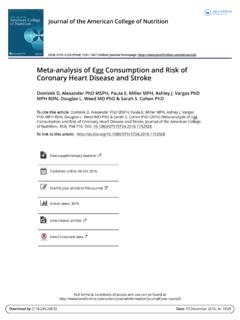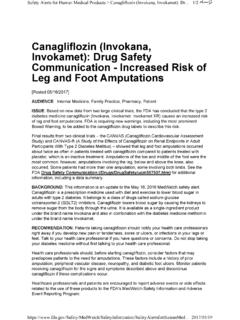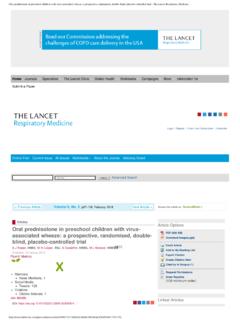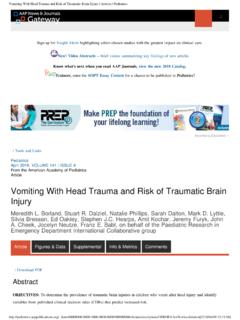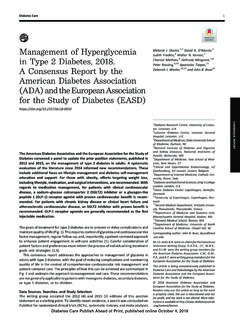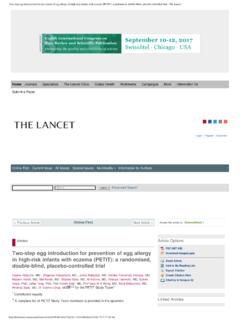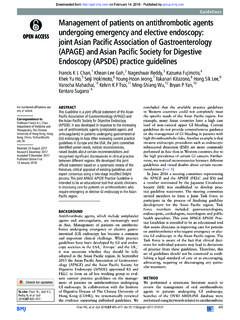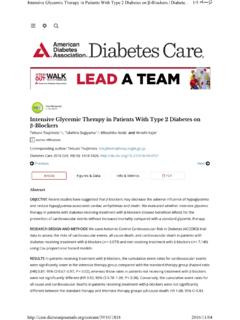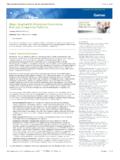Transcription of Standards of Medical Care in Diabetes—2018 Abridged for ...
1 CLINICAL DIABETES 1 EDITORIALPOSITION STATEMENTThe American Diabetes Associ-ation s (ADA s) Standards of Medical Care in Diabetes are published each year in a supplement to the January issue of Diabetes Care. The ADA s Professional Practice Committee develops the Standards and updates them annually, or more frequently online should it determine that new evidence or regulatory chang-es ( , drug approvals, label changes) merit immediate incorporation. The Standards include the most current evidence-based recommendations for diagnosing and treating adults and children with diabetes. ADA s grad-ing system uses A, B, C, or E to show the evidence level that supports each recommendation.
2 A Clear evidence from well- conducted, generalizable random- ized controlled trials that are ade-quately powered B Supportive evidence from well-conducted cohort studies C Supportive evidence from poorly controlled or uncontrolled studies E Expert consensus or clinical experienceThis is an Abridged version of the Standards containing the evi-dence-based recommendations most pertinent to primary care. The tables and figures have been renumbered from the original document to match this version. All of the recommenda-tions (bulleted text) are precisely the same as in the full Standards of Care. The complete 2018 Standards of Care document, including all supporting references, is available at CARE AND PROMOTING HEALTH IN POPULATIONS Over the past 10 years, the proportion of patients with diabetes who achieve recommended A1C, blood pressure, and LDL cholesterol levels has in-creased.
3 The mean A1C nationally among people with diabetes has de-clined from (60 mmol/mol) in 1999 2002 to (55 mmol/mol) in 2007 2010 based on the National Health and Nutrition Examination Survey, with younger adults less likely to meet treatment targets than older adults. This has been accompanied by improvements in cardiovascular outcomes and has led to substantial reductions in end-stage microvascular complications. Nevertheless, 33 49% of patients still do not meet targets for glycemic, blood pressure, or cholester-ol control, and only 14% meet targets for all three measures while also avoid-ing smoking. Optimal diabetes management requires an organized, systematic approach and the involvement of a coordinated team of dedicated health care professionals working in an environment where patient-centered high-quality care is a priority. Recommendations Ensure treatment decisions are timely, rely on evidence-based guidelines, and are made collab-oratively with patients based on Standards of Medical Care in Diabetes 2018 Abridged for Primary Care ProvidersAmerican Diabetes AssociationThis is an Abridged version of the American Diabetes Association s Standards of Medical Care in Diabetes 2018.
4 Diabetes Care 2018;41(Suppl. 1):S1 S159. The complete 2018 Standards supplement, including all supporting references, is available at 2018 by the American Diabetes Association. Readers may use this article as long as the work is properly cited, the use is educational and not for profit, and the work is not altered. See http:// for Diabetes Online Ahead of Print, published online December 8, 20172 POSITION STATEMENT individual preferences, prognoses, and comorbidities. B Align approaches to diabetes management with the Chronic Care Model, emphasizing pro-ductive interactions between a prepared proactive care team and an informed activated patient. A Care systems should facilitate team-based care, patient regis-tries, decision support tools, and community involvement to meet patient needs.
5 B Efforts to assess the quality of diabetes care and create quality improvement strategies should incorporate reliable data metrics, to promote improved processes of care and health outcomes, with simultaneous emphasis on costs. E Tailoring Treatment for Social Context Health inequities related to diabetes and its complications are well docu-mented and are heavily influenced by social determinants of health. Social determinants of health are defined as the economic, environmental, polit-ical, and social conditions in which people live and are responsible for a major part of health inequality world-wide. The ADA recognizes the associ-ation between social and environmen-tal factors and risk for diabetes and its Providers should assess social context, including potential food insecurity, housing stability, and financial barriers, and apply that information to treatment decisions.
6 A Refer patients to local community resources when available. B Provide patients with self-man-agement support from lay health coaches, navigators, or community health workers when available. A CLASSIFICATION AND DIAGNOSIS OF DIABETES Diabetes can be classified into the following general categories: 1. Type 1 diabetes (due to autoim-mune -cell destruction, usually leading to absolute insulin defi- ciency) 2. Type 2 diabetes (due to a pro-gressive loss of -cell insulin secretion frequently on the back-ground of insulin resistance) 3. Gestational diabetes mellitus (GDM) (diabetes diagnosed in the second or third trimester of pregnancy that was not clearly overt diabetes prior to gestation) 4. Specific types of diabetes due to other causes, , monogenic diabetes syndromes (such as neo-natal diabetes and maturity-onset diabetes of the young), diseases of the exocrine pancreas (such as cystic fibrosis and pancreatitis), and drug- or chemical-induced diabetes (such as with gluco-corticoid use, in the treatment of HIV/AIDS, or after organ transplantation) Diagnostic Tests for Diabetes Diabetes and prediabetes may be screened based on plasma glucose cri-teria, either the fasting plasma glucose (FPG) or the 2-h plasma glucose (2-h PG) value during a 75-g oral glucose tolerance test (OGTT), or A1C cri-teria (Table 1).
7 There is incomplete concordance between A1C, FPG, and 2-h PG, and the 2-h PG diagnoses more people with diabetes than the FPG or A1C. Marked discrepancies between mea-sured A1C and plasma glucose levels should prompt consideration that the A1C assay may not be reliable for that individual, since a relatively small percentage of patients have conditions such as sickle cell trait or hemoglobinopathies that skew A1C results. See the full 2018 Sta nda rd s of Care for conditions causing dis-crepancies. Unless there is a clear clinical diagnosis based on overt signs of hyperglycemia, a second test is required for confirmation, either repeating the same test used initially or a different test. If patients have test results near the margins of the diagnostic threshold, the health care professional should follow the patient closely and repeat the test in 3 6 months.
8 Categories of Increased Risk for Diabetes (Prediabetes) Prediabetes is the term used for in-dividuals whose glucose levels do not meet the criteria for diabetes but are too high to be considered normal (see Table 1). Prediabetes should not be viewed as a clinical entity in its own right but rather as an increased risk for diabetes and cardiovascular disease (CVD).Recommendations Screening for prediabetes and risk for future diabetes with an infor-mal assessment of risk factors or validated tools should be consid-ered in asymptomatic adults. B Testing for prediabetes and risk for future diabetes in asymptom-atic people should be considered in adults of any age who are over-weight or obese (BMI 25 kg/m2 or 23 kg/m2 in Asian Americans) and who have one or more addi-TABLE 1. Criteria for the Screening and Diagnosis of * FPG100 125 mg/dL ( mmol/L)* 126 mg/dL ( mmol/L) OGTT140 199 mg/dL ( mmol/L)* 200 mg/dL ( mmol/L) RPG 200 mg/dL ( mmol/L) *For all three tests, risk is continuous, extending below the lower limit of the range and becoming disproportionately greater at the higher end of the range.
9 In the absence of unequivocal hyperglycemia, results should be confirmed by repeat testing. Only diagnostic in a patient with classic symptoms of hyperglycemia or hyperglycemic crisis. RPG, random plasma Diabetes Online Ahead of Print, published online December 8, 2017 CLINICAL DIABETES 3a b r i d g e d s ta n d a r d s o f c a r e 2018tional risk factors for diabetes (Table 2). B For all people, testing should begin at age 45 years. B If tests are normal, repeat test-ing carried out at a minimum of 3-year intervals is reasonable. C To test for prediabetes, FPG, 2-h PG during 75-g OGTT tolerance test, and A1C are equally appro-priate. B In patients with prediabetes, iden-tify and, if appropriate, treat other CVD risk factors.
10 B Testing for prediabetes should be considered in children and adoles-cents who are overweight or obese (BMI >85th percentile for age and sex, weight for height >85th percentile, or weight >120% of ideal for height) and who have additional risk factors for diabetes (Table 3). E COMPREHENSIVE Medical EVALUATION AND assessment OF COMORBIDITIES Patient-Centered Collaborative Care Recommendation A patient-centered communication style that uses person-centered and strength-based language, active lis-tening, elicits patient preferences and beliefs, and assesses literacy, numeracy, and potential barriers to care should be used to opti-mize patient health outcomes and health-related quality of life. BComprehensive Medical Evaluation Recommendations A complete Medical evaluation should be performed at the initial visit to: Confirm the diagnosis and classify diabetes.
